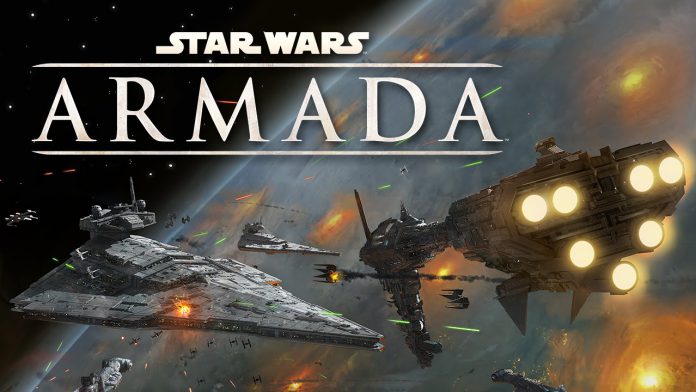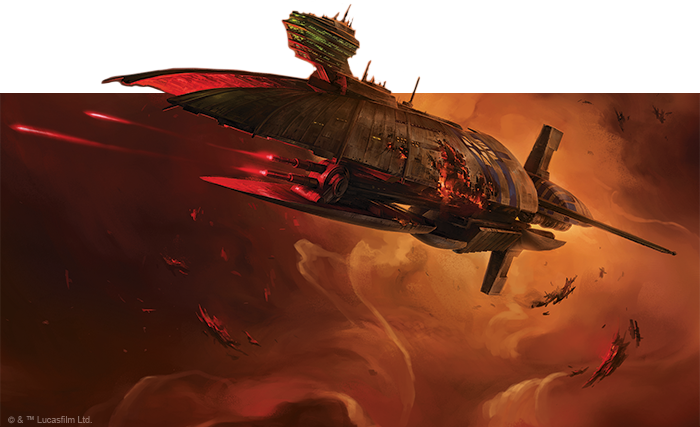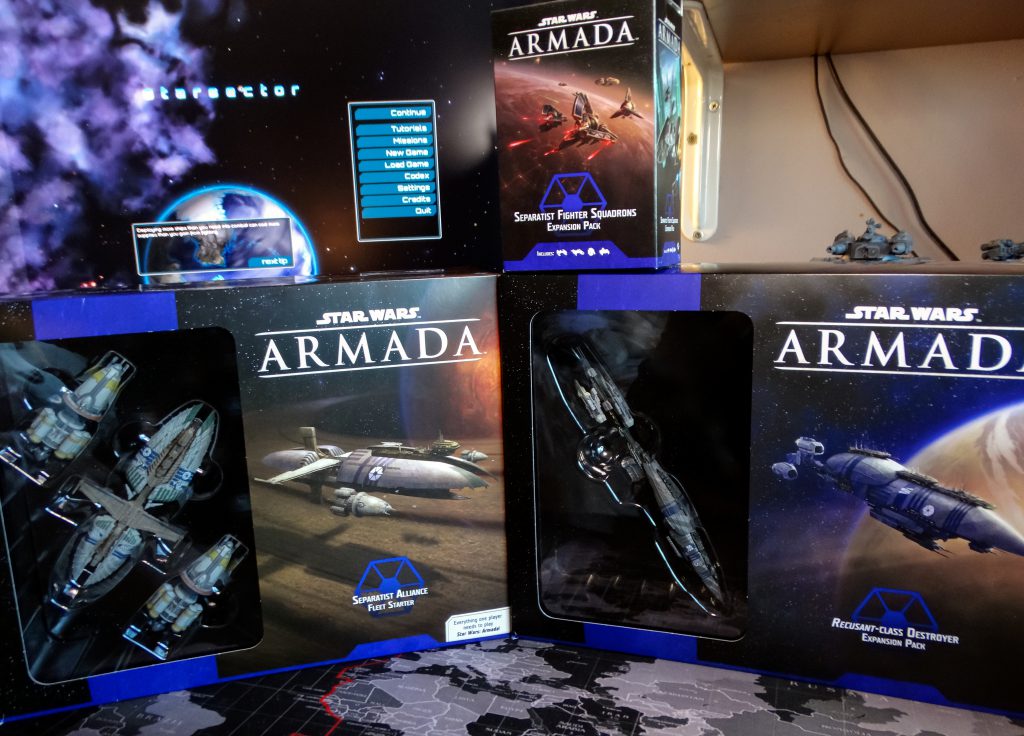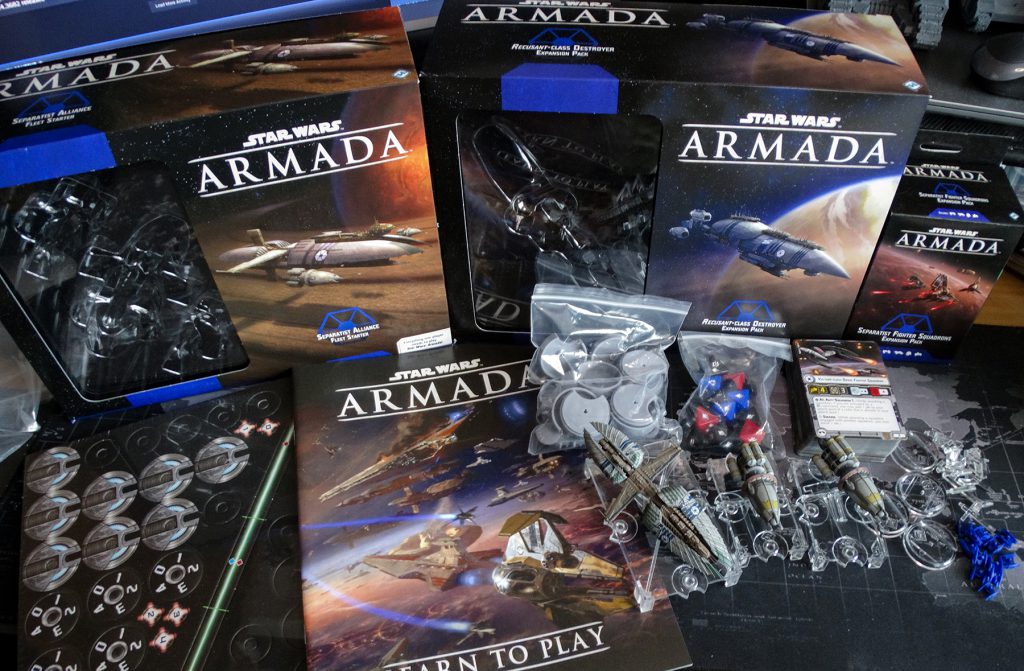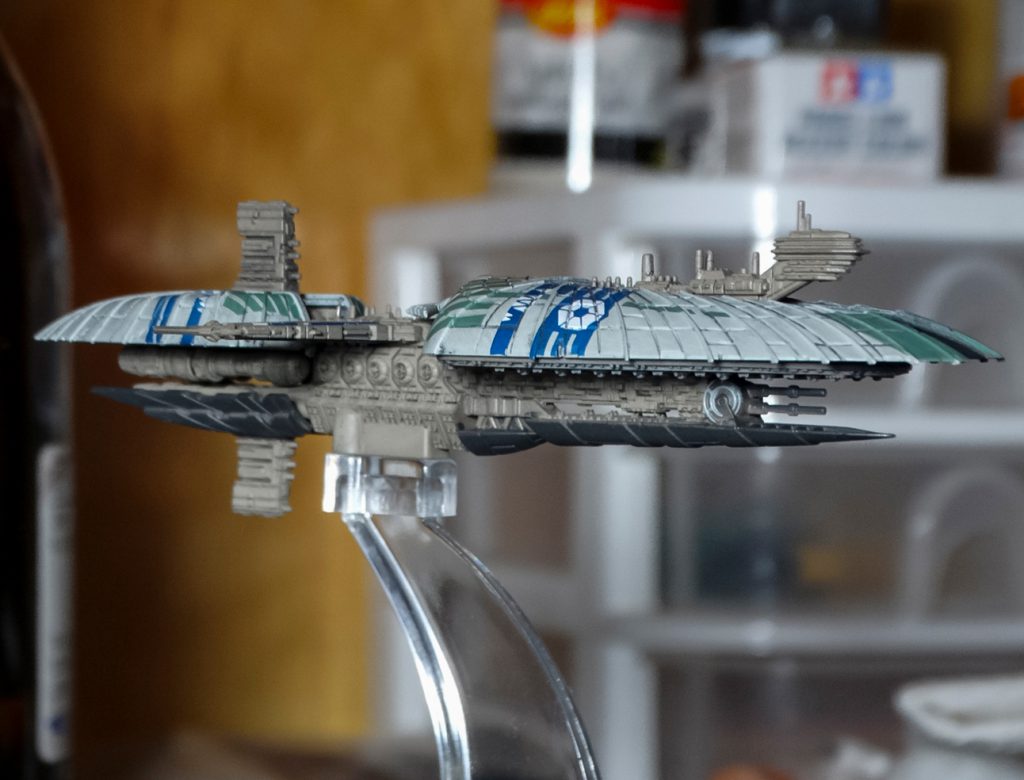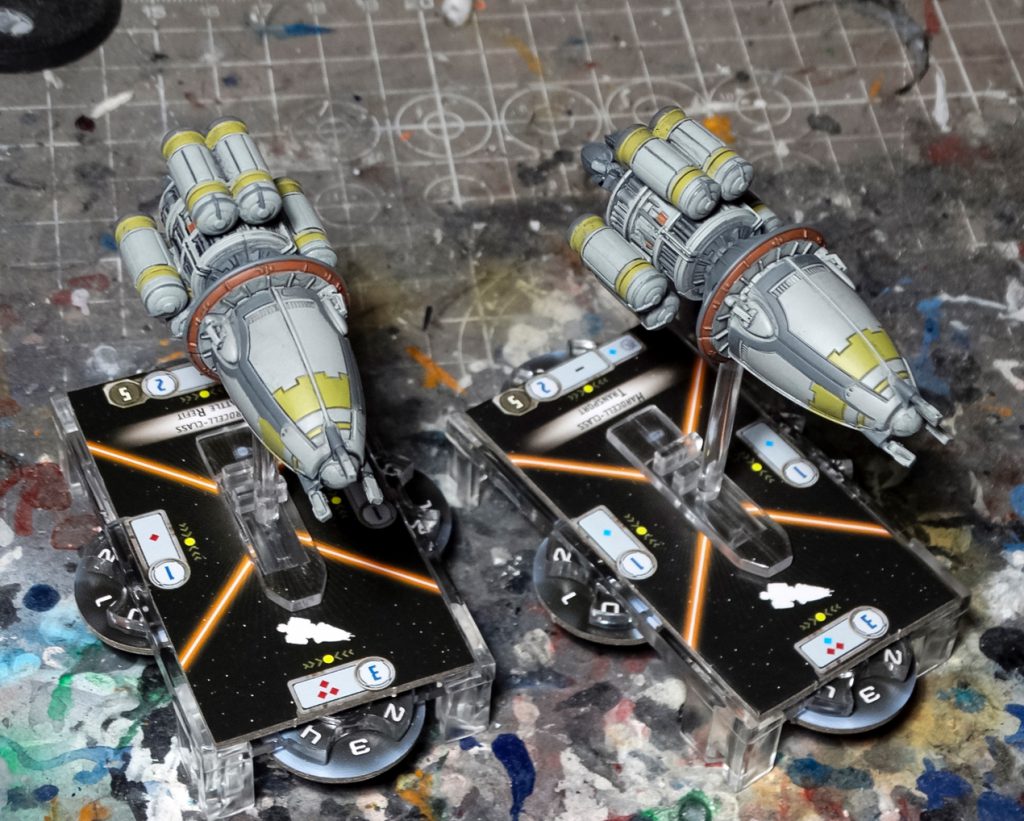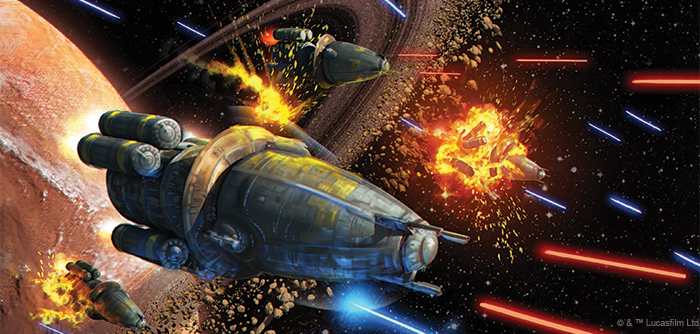Summer saying hi again. I’m here to make Bair happy by jabbering about Separatist ships. Specifically, I’ll be unboxing and reviewing the Separatist collection over two articles. The whole thing.
War! – “The Jedi will be overwhelmed.”
First, my gratitude and hugs to Atomic Mass Games, who sent the Separatist Alliance Fleet Starter, Recusant-class Destroyer Expansion Pack, and Separatist Fighter Squadrons Expansion Pack for review. I paired this with an Invisible Hand Expansion Pack I purchased, leaving us with a complete Separatist collection to review.
The Separatist collection contains
- Separatist Alliance Fleet Starter – An entry point into Armada with a medium ship and two small ships, plus a smattering of squadrons. It also has all the tools and accessories needed to set up a game. Analogous to a one-faction starter box in other games.
- Invisible Hand Expansion Pack – A large-base Providence-class warship with a selection of upgrades. The heavier and more versatile of the two Separatist large ships.
- Recusant-class Destroyer Expansion Pack – A large-base Recusant-class warship with accompanying upgrades and tools. The Recusant is the definitive glass cannon in Armada and has a rather unique playstyle for its weight class.
- Separatist Fighter Squadrons Expansion Pack – An expansion with two-each of four types of fighter squadrons.
It’s a sizable pile of stuff, and one copy of everything is more than enough to field a standard-sized (400 point) game with room to flex.
A word about dials
Since the Clone Wars releases, the developers have stopped including vital speed dials and command dials in new expansions. The Fleet Starters now contain an overabundance of dials and more can be bought separately. This happened under Fantasy Flight Games’ (FFG) direction and has had a split reception. Some players don’t like it because it seems like nickel and diming over tools while complicating procurement for a game that was always unbox-and-play. Others adore the decision because they were storing a mountain of dials from past expansions that have no use.
Oh, and none of this applies to Galactic Civil War stuff, so Rebel and Imperial players are safe from the debate.
No matter your stance, here’s the math: if you have a Separatist Alliance Fleet Starter, you have enough dials to field the contents of that Fleet Starter and both large Separatist ships simultaneously. You will not need more dials unless you buy more large ships.
Protip: Veteran Armada players are drowning in speed and command dials and will give you a pile in exchange for, like, a chocolate bar. We usually have lots of spare dice, damage decks and range rulers too.
Unboxing – “What’s in the box?!”
Since the Separatists (and their hated foes) were the last ship releases before Armada’s release hiatus, they’re the most up-to-date. The models are presented in display packaging and each box spits out a solid pile of cards and punch-out tokens. The Fleet Starter is especially lovely because it clown cars a pile of bits and bobbins that can cover a desk. You will be provoked into developing a system to organise your collection.
I love unboxing Armada because its hits different from 40K. My mindset in opening a 40K box is planning and exploration. I’m filled with assembly orders and colour schemes. I need to integrate projects into my hobby plans. Opening Armada is different. It’s like opening up a new toy: you pull out a pre-assembled and painted miniature and have it on a base within two minutes. There’s the glee of punching out cardboard tokens and flicking through full-colour upgrade cards. Then you’re done. You have a new toy ready for display, or the table.
People who are accustomed to build-paint-play games can feel weird when opening a complete product. Others open a 40K kit and feel overwhelmed by the IKEA-esque some assembly required nature of that hobby. I think it’s important to appreciate both sides of the world. Games like Armada are for people who don’t necessarily have the desire to painstakingly assemble models before playing. People might just want to get a new toy on the table. Conversely, I live for the hobby side of 40K and every new build is its own joyful experience. Find the mindset that works for you.
Separatist Alliance Fleet Starter
The Separatist Alliance Fleet Starter is billed as an all-in-one starter experience for Armada. The contents match its Republic counterpart, and they are the quickest way to start playing Armada if you like the Clone Wars era factions.
The box is neatly divided between the ships displayed in a window, and everything else concealed behind cardboard inserts. AMG and Fantasy Flight Games’ cardboard manufacturing infrastructure is on full show here. Expect many punch-out tokens and high-quality printed cards with a satin finish. Everything that’s not a ship is separately wrapped and bagged. Nothing is scratched on arrival.
The Models
Okay, this is what we’re here for.
The Fleet Starter gives you a medium-base Munificent and two small-base Hardcells. This amounts to a complete fleet for smaller games, or the core of a standard fleet.
The Munificent is by far the more interesting design. It has sloping, beetle-like curves with lots of spindly bits and ridges. It bears standard Separatist livery with blue and green striping on a grey hull. The design is thoroughly alien, and a healthy break from the angry space triangles we’re accustomed to.
Hardcells were first seen in Attack of the Clones. We were treated to the awesome scale of these vertically launched support ships during the Battle of Geonosis. Each ship was a skyscraper under which whole platoons scuttled like ants. The collapsing fuel tanks on one Hardcell smashed dozens of battle droids unimpeded. This is the smallest class of ship in Armada.
These ships are delivered in Battle of Geonosis livery. You can generally expect Armada’s ships to be painted as they were depicted onscreen (if they were). They’re oddly cute in a retro sci-fi rocketship way. Rounded hulls and a trio of landing legs complete the cartoon look.
Lastly, there are four of the expendable Vulture-class droid fighters. They’re cast in plastic and fitted to flight stands. Armada’s squadrons are unpainted, but are cast in a colour reflecting their faction. Separatist squadrons are blue. They’re humble in scope, and dwarfed in impressiveness by the ships around them.
Unboxing protip: Plastic injection moulding can lead to manufacturing differences between items intended to fit together. This can become an issue if a particular flight stem and model fit poorly. If a gentle push doesn’t get the piece in, don’t be afraid to trim something. I usually file down the seam on ship stems, and scrape the plug on squadrons with a knife to get a better fit. It’s better to have a softer fit than suffer damage when you disassemble something for travel.
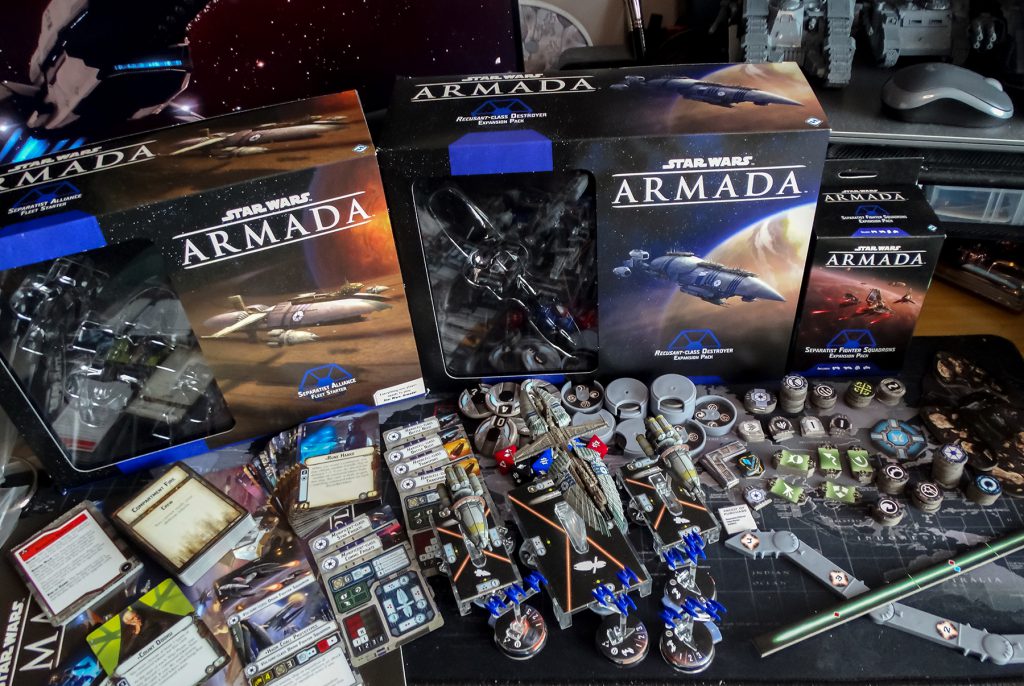
The Upgrades
Rather than badly photographing the cards or linking to every single one, I will direct you to this wiki page which has a complete list of contents.
Short story long, all Armada ships come with a few relevant upgrade cards that can be used with the ship in the box. Upgrade cards are how Armada manages special abilities. They provide dice control, squadron support, gimmicks and waaay more.
The most important upgrades are the two Commander cards. Commanders lead fleets and define the list with their powerful abilities. The Fleet Starter gives Count Dooku and Kraken.
Kraken is simpler: he gives your ships dice control when they swarm an opponent. Kraken’s gameplay favours ship spam, which pairs nicely with the three vessels in the box. He’s also a fan favourite for the time he entered lightsabre range of Anakin Skywalker and got three punches into the Chosen One.
Dooku is more complex. I’ll discuss him more in future articles, but his thing is mass-debuffing the enemy fleet. Twice per game, he can coat the enemy fleet in a raid token you chose at the beginning of the match. Raid tokens prevent a ship from resolving a given command until the token is discarded. This is awful for ships that depend on specific commands (like carriers) and frustrating for any other ship. The difficult part is taking advantage of the window he gives. I’ll discuss him more later, but if you do want to play Dooku, print Asajj Ventress from the Rapid Reinforcements 2 print-and-play expansion to back him up.
I’ll shout out a few of the other numerous upgrades that are particularly good or interesting.
Firstly, the four titles (unique ship variants) in the box are all hits.
Both of the Munificent titles (Sa-Nalaor and Tide of Progress XII) key into defence in interesting ways. Sa-Nalaor favours a more mobile playstyle where the player usually sacrifices the firepower of their Salvo token to squeeze out survivability. Tide of Progress XII is a take-punches card that pairs great with Medical Team or Battle Droid Reserves to keep debilitating criticals off your back.
For the Hardcells, Foreman’s Labor increases raw durability and Beast of Burden fits into the Hardcell’s support role by keeping friendly ships alive.
The two Resupply cards (Parts and Munitions) are also instant hits for every Armada faction that needs tokens. These two cards are the definitive way to power-wash your fleet with Repair and Concentrate fire tokens. Be mindful of the fact that only Transport Hardcells can fit this support upgrade.
T-Series Tactical Droids and Wat Tambor are both forgiving to new players and useful to experienced players. The Tactical Droid fits best on Command 2+ ships that can store tokens to convert into more powerful Dial commands. Ideal for resolving a command different to the one you planned for, or resolving your ship’s second-choice command earlier. Wat Tambor is a defensive officer that redistributes shields to his ship. Generally, you’ll be sucking shields from a low-priority ship to give to his ship, or using it as a Redirect with fewer constraints.
The Stuff
The rest of the box is dedicated to tools, tokens, and other cards. There are critical play aids: a maneuver tool, range ruler, dice, damage deck, reference cards, and scenery. There’s an up-to-date rulebook with Clone Wars era cover art and enough command + speed dials for the Starter plus a couple of large expansion packs. There are also a lot of tokens in this box. The included ziplock bags are a starting point, but you will want better storage.
I don’t know about others, but punching out cardboard tokens brings me the same glee as popping bubble wrap. Something about applying pressure, feeling something gently pop out and seeing the damage I’ve wrought.

Separatist Fighter Squadrons Expansion Pack
Armada’s fighter expansions are humbler than Fleet Starters. Still, they’re a great direction to go in. Almost every buyer’s guide-type article/video for Armada recommends a fighter pack somewhere in the top three.
The first Fighter Squadron pack for a given faction will always contain essentials. There’s always a general purpose fighter, bomber, interceptor and a wildcard. For Separatists, that means 2 Vultures (fighter), 2 Tri-fighters (interceptor), 2 Hyenas (bomber), and 2 Belbullab-22s (support fighter).
There are squadron models in faction-colour plastic, clear bases and flight stands. Two sheets of punch-out cards with discs and tokens used to track stats and abilities are slotted into the back of the box.
The pack has 10 possible units with a few standouts. The developers leaned hard on the agile-and-expendable theme for Separatist squadrons. They are cheap and their aces have abundant access to the supreme Scatter token. This is balanced by the AI keyword, which makes them less cost effective unless they’re commanded by a ship. The strengths and weaknesses of droid fighters are well-reflected.

Some standouts include…
General Grievous (Bellbulab-22) has monster durability and a great special rule for squadron hunting. His special ability is best used against generic squadrons without defence tokens, but he can be used to pounce on a weakened ace and eliminate it. This is helped nicely by Screen, which lets him use your chaff fighters for protection. A fitting card the coughing weirdo.
The main thing that keeps interceptors balanced is fragility. DIS-T81 (Tri-fighter) addresses this issue with the Snipe keyword, and a special ability that amounts to ignoring cover. The point of this squadron is to be a backline sniper and engage at a range where most enemies cannot hit you.
DFS-311 continues the tradition of being a very strong defensive ace by forcing re-rolls on attacks while it is obstructed. Most anti-squadron attacks are piecemeal things, so striking one off one die with obstruction and forcing a re-roll can save your bacon. There’s also the excellent Scatter + Brace defence token suite.
The Separatist Fighter Squadrons pack left me more satisfied than either of the first Imperial or Rebel squadron packs. This pack has more unit cards (+2), and there were no dud squadrons (RIP TIE Advanced). A Fighter Squadron pack is a big boost to a collection’s power despite its size. This one doesn’t disappoint.
Unboxing protip: Armada fighters are small and the two-part plastic flight stems are notorious for breaking. Always be firm, but gentle when pressing fighters into a stem. Be mindful to apply force directly down the stem, rather than laterally as that may lead to a snapped stem. When attaching the stem to the base, note that the bottom of the stem is a semi-circle which slots into a matching hole in the base. Line them up gently and do not force it.
Thoughts – “You have permission to refer to me as Darth Sidious.”
That was fun. And thorough. I can’t stress enough the joy of opening a wargaming item and not feeling like I’ve started another assembly and painting project. I have a lot of those sitting unfinished at the workstation, so this is a nice break from that feeling.
The Fleet Starter is a lot more comprehensive than the starting point from over half a decade ago. It’s aimed at one player, but you could split the contents between two people if they want a different share of ships. The best thing about Fleet Starters is that they break away from the Core Set’s feeling of incompleteness. The older two-player Core Set left the Empire with one ship and the Rebels with two (one of which was ineffectual). It felt more like a sample scenario than an entry point into a wargame. This is a good starter and covers most of the distance to a standard-sized list.
The Separatist Fighter Squadrons continue the long tradition of indispensable squadron expansions. It has all of the essential unit types and does great at shoring up the four Vultures from the Fleet Starter. You won’t need a second one unless you lean hard into squadron gameplay. The best feature isn’t even the models or stats. They did away with the clamshell packaging of old squadrons. It’s just cardboard and plastic wrap. My fingers paid the price dearly on that old packaging.
Anyway, this was only Part 1. We’ll talk about the Separatist behemoths next time. See you in space.
Have any questions or feedback? Drop us a note in the comments below or email us at contact@goonhammer.com.
